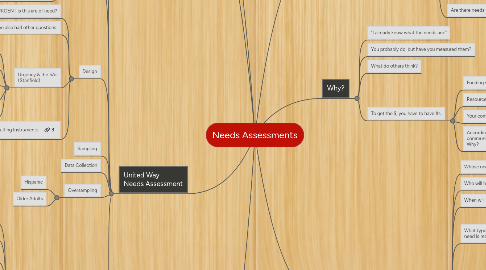
1. Royse & Thyer's (1996) Reasons
1.1. Do services exist in the community?
1.2. Are there enough clients?
1.3. Who uses existing services?
1.3.1. Important
1.4. Any barriers to getting services?
1.4.1. Lauderdale Co. Alabama
1.5. Are there needs that we don't know about?
2. a.k.a.
2.1. feasibility studies
2.2. front-end analyses
2.3. strengths assessments
3. Why?
3.1. "I already know what the needs are."
3.2. You probably do, but have you measured them?
3.3. What do others think?
3.4. To get the $, you have to have #s.
3.4.1. Funding sources have to make tough decisions.
3.4.2. Resources are limited.
3.4.3. Your community needs to appear ready to measure change.
3.4.4. According to Hudson's Axioms, your community's needs may not exist. Why?
4. What we will cover
4.1. Why?
4.2. How?
4.3. Who?
4.3.1. Decides on the questions?
4.3.2. Answers them?
5. Designing the Assessment (Marlow)
5.1. Whose need is being assessed?
5.2. Who will have input into the design?
5.3. When will data be collected?
5.4. What type of understanding of need is required?
5.4.1. Quantitative
5.4.2. Qualitative
5.4.3. Both
5.5. What level of description is useful?
5.5.1. Are you interested in relationships between variables?
5.5.2. If so, you can do an ex post facto design.
5.5.3. Variables are not being manipulated, you are just describing associations.
5.5.4. Example
5.5.5. Needs Assessments are descriptive by nature, and therefore do not contain IVs & DVs in the traditional sense.
6. United Way Needs Assessment
6.1. Reason
6.1.1. Roll-over funding of programs
6.1.2. Wanted to be more proactive
6.1.3. National UW one was expensive
6.2. Committee
6.2.1. Too big
6.2.2. Everyone wanted their area of interest represented.
6.2.3. People did ask some good questions.
6.3. Design
6.3.1. How URGENT is this are of need?
6.3.2. But we also had other questions.
6.3.3. Urgency & the 5As (Stanfield)
6.3.3.1. Are services AVAILABLE?
6.3.3.2. Are people AWARE of them?
6.3.3.3. Are they AFFORDABLE?
6.3.3.4. Are they ACCESSIBLE?
6.3.3.5. Are they ADEQUATE?
6.3.4. Resulting Instruments
6.4. Sampling
6.5. Data Collection
6.6. Oversampling
6.6.1. Hispanic
6.6.2. Older Adults
6.7. Analysis
6.7.1. Formula
6.7.1.1. Urgency was on a 5 point scale
6.7.1.2. Each A was on a 5 point scale
6.7.1.3. Since there are 5 As we multiplied Urgency x5,
6.7.1.4. which gave us an equal scale.
6.7.1.5. The result was Remaining Need.
6.7.1.5.1. Example
6.7.1.6. Reports
